Follow our recent posts by visiting the Stream page, explore our roster of bands at Gigantic Monster Records, or view our zine archive through our Publishing page.
You can also download music, watch videos, or read articles by using the Sidebar to the left. Organized by type for your convenience.
The Dark [1979]
Last modified on 2020-08-01 20:46:32 GMT. 1 comment. Top.
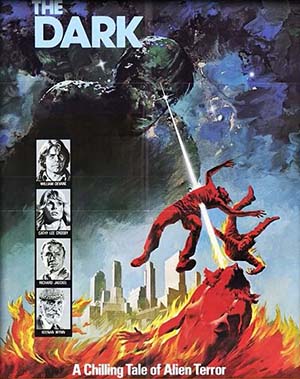
Who or what is the terrible menace? Serial killer? Zombie on the loose? Destructive alien lifeform sans motive? Movie poster and text crawl spoilers aside, discover the horrible truth only by watching The Dark!
By no means is this movie high brow, top tier material, but it’s not bottom of the barrel either. It’s flawed in its execution, but still less torturous than comparable pictures. It’s derivative, trend riding, B-movie schlock, but at least it’s not Z-grade, no budget, poorly dubbed foreign fare.
In the audio/video department, The Dark is technically sound, and despite allegations of excessively dark cinematography, the film is primarily watchable, at least in an aesthetic sense. While the soundtrack may leave something to be desired, the audio itself is clear and the speech intelligible. Compositionally, this movie is also a strong performer, featuring various angles and tracking shots that wouldn’t be attempted in lesser budget offerings.
The Dark also has the dubious advantage of cast, featuring reputable actors William Devane (Knots Landing), Philip Michael Thomas (Miami Vice), and Kasey Casem (Scooby-Doo, American Top 40). While there may not be any heavy hitting star power, the acting works well enough for this style of film and is surprisingly palatable.
Where this flick stumbles is that it has no idea what it is, or where its going. Despite the initial and temporary involvement of Tobe Hooper (Texas Chainsaw Massacre), the direction, and (especially) writing simply falls flat. None of the characters are particularly interesting, and none of the investments or set ups ever really pay off. The Dark is one of those movies where things are constantly happening, but the action is always divorced from any true context. Things keep advancing, yet not due to any particular involvement by any of the main characters. It’s almost as if the antagonist and protagonists never collide, although they’re ostensibly in the same universe. Dick Clark’s odd role of co-producer did apparently little for creative oversight, as the plot tries to go in multiple opposing directions.
The production is similarly found wanting in the special effects department, which are not only sloppy and clearly Star Wars influenced, but have an awkward glue-on feel, which isn’t the only aspect of this motion picture that is artificial and contrived.
The Dark is dogged by its many forced-fit, pasted together segments and shoehorned tropes. Regardless of ambiguous psychic help (no, not from Philip Michael Thomas!), and the lack of any solid police work, somehow all the relevant characters find their way from point A to point B. Along the way, we’re treated to arbitrary jump scares, a nonsensical car chase, a laughable montage, and the obligatory hero saves the day moment, which ends up being very clumsy, anti-climactic, and improbable (not to mention being stupidly risky and ill-advised).
What The Dark has going for it is that it falls into that narrow sweet spot of not being abysmal enough to be punishing, yet still bad enough to provide a certain classless entertainment. It’s likable as a brain-dead, vapid, train-wreck of a flick, prime for late-night witticisms among friends, or snarky Youtube commentaries. Which, let’s face it, is really the primary impetus behind B-movie fandom amongst today’s Ironic Generation.
Accessing our premium content requires a password. To receive the password, please Like us on Facebook and send a message to our page.
Daughter of Darkness [1990]
Last modified on 2020-08-01 20:43:47 GMT. 0 comments. Top.
a.k.a. In Defense of Daughter of Darkness
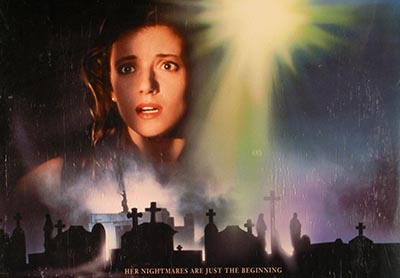
If you’re familiar with this movie, you’re almost definitely a Stuart Gordon fan or you just happened to stumble upon it during its initial broadcast in 1990-91. This vampire flick has been pretty much forgotten, and those who do still remember Daughter of Darkness tend to withhold any praise. Those who are blockbuster fans will dismiss it as a bland, slow-paced, made-for-TV movie with cardboard characters, and those who haunt more macabre realms will claim that it doesn’t measure up to Gordon’s better known films, such as Re-Animator and From Beyond.
Well, I suppose if you’re a gore-hound splatter-freak, or are expecting A-list actors in a big-budget production then you’ll want to avoid this, but I think Daughter of Darkness has its own strange charm. It’s more sedate than say, Dagon; it doesn’t try to assault you with jump scares or too much action. It’s not a masterpiece and it doesn’t pretend to be. It’s something that you can watch just for the sake of being told a cool little story. It’s quite moody and atmospheric, it places an original spin on the traditional Hollywood vampire, and it’s well-cast.

David Bowie in The Hunger
The Eastern European setting is perfect for a vampire story (hello Transylvania!), and the set design is suitably creepy. There’s some disturbing character to the locale without it getting too far fetched, and the same thing can be said with respect to the vampire characters. They were stylish, hip, and interesting enough to keep some mystique and intrigue, but not so over-the-top or garish that you want to roll your eyes. As far as vampires walking amongst the living goes, it was plausible enough that I could suspend my disbelief, but edgy enough to keep me enthralled. The vibe was a little more campy than Tony Scott’s The Hunger, but not as absurd as Queen of the Damned.
Speaking of vampire movies that came before, one refreshing thing about this flick is that it doesn’t follow all the nosferatu / Dracula cliches blindly. No, the vampires aren’t conceptually radically different from Chris Sarandon in Fright Night, but, of course, they wouldn’t be vampires if they didn’t drink blood. There’s no doubt there’s a common heritage there, but it was surprising to see Daughter go way back to certain aspects of the old Polish mythologies, and become a little more low-brow than “The Count”.
 Also surprising is how they afforded the cast, who, at the time, were relatively bankable. The caliber of talent in Daughter is a little higher than most other Gordon films (or b-movies in general). We’ve got Anthony Perkins (Psycho) to add a little horror cred, Mia Sara (Ferris Buller, Legend) as an affordable, yet loveable starlet, as well as Jack Coleman (Dynasty) because, well, who else do you turn to when you need a good looking guy for a TV series / TV movie? Mostly everyone else is local talent (Eastern European), but the roles all fit, and the Max character comes off perfectly as an endearing local yokel.
Also surprising is how they afforded the cast, who, at the time, were relatively bankable. The caliber of talent in Daughter is a little higher than most other Gordon films (or b-movies in general). We’ve got Anthony Perkins (Psycho) to add a little horror cred, Mia Sara (Ferris Buller, Legend) as an affordable, yet loveable starlet, as well as Jack Coleman (Dynasty) because, well, who else do you turn to when you need a good looking guy for a TV series / TV movie? Mostly everyone else is local talent (Eastern European), but the roles all fit, and the Max character comes off perfectly as an endearing local yokel.
Another strange thing about the production of this movie is that it was made-for-TV, yet is Rated R. There’s not an excessive amount of gore (especially compared to other Stuart Gordon films), but there are topless and scantily clad females. This was also at a time when Cinemax / HBO were the only stations that would touch that kind of material unedited, yet there are clearly defined “commercial break” sections present. Odder still, this ended up being a late-night broadcast for CBS (minus the breasts, of course) which was a bit racy, especially considering they were running a lot of Hallmark movies at the time.
As far as technical execution goes, the cinematography is hit-or-miss. There are some stylized and beautiful shots (sunsets, of course) and some interesting dutch angles, but there are various parts where it looks like different film stocks have been used, or the film was developed differently. I think this was a by-product of super-imposing video titling over the film, but it makes those few sections look like stock footage. How distracting.
The audio is a mixed bag as well. Daughter of Darkness was produced in 1989, and Hellraiser 2 had just been released to wide acclaim, so it’s no surprise that you can find hints of Christopher Young (composer of Hellraiser) in the Daughter main theme. Originality aside, the movie is well-scored, and there’s even a bit of cleverness when one of the characters plays a version of the main theme on harpsichord. The incidental music (played in a night club) is very ’80s and hasn’t aged well, but it does suit its purpose. The fault in the audio, however, is that there are parts where the dialogue becomes really loud and then really quiet again. Not to the point where you can’t make out what is being said, but it’s not natural or smooth sounding either. But hey, this was over 20 years ago when digital technology was just starting to become a normal part of living, so I’m not sure I should complain.
What I would like to whine about, however, is that the only official release of Daughter of Darkness (in North America, at least) was in the form of VHS and laserdisc, and both are long out of print. Even DVD bootlegs are hard-to-find and are of poor quality. The up-side is that we’ve obtained a high-quality digital transfer and made it available for your viewing pleasure. (Besides, how many people still have their VCR hooked up, or even owned a laserdisc player?) This is most likely the best version in existence (besides the original masters), and the only one available on the Net.
Accessing our premium content requires a password. To receive the password, please Like us on Facebook and send a message to our page.
Stephen King’s – N.
Last modified on 2021-05-30 08:55:23 GMT. 0 comments. Top.
Based on a novella in the Stephen King collection Just After Sunset, N. is a story within a story based around a mental patient whose obsessive-compulsive disorder may or may not keep the veil between two worlds from being lifted. Is he delirious? Is it contagious? Or are his compulsions the only thing keeping this world from being unraveled by Darkness?
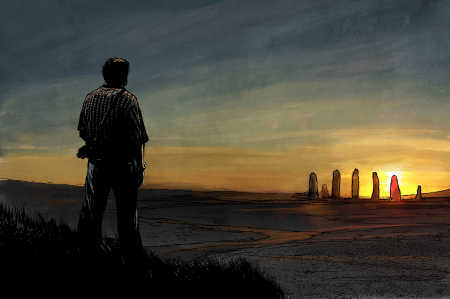
Similar to the Stephen King novel The Plant, N. is an experimentation in publishing. N. is a 25-part “motion comic”, with each segment being only 1.5 minutes long, making the total running time about 30 minutes. The animation is done in cutout style, much like Krabat – The Sorcerer’s Apprentice, except modernized and digital, placing it in a category almost by itself. With the exception of Watchmen – Tales of the Black Freighter, there are few titles blending similar technical style with dark subject matter.
While the format, delivery, and medium is daring in itself, the most refreshing thing about N. is that there is no precise antagonist. It’s certainly arguable that King’s anthropomorphic antagonists are generally forgettable, but regardless, he’s at his best when working with characters in unusual situations rather than resorting to direct conflict between hero and villain. It’s the situation and scenario that tends to frighten the most, instead of graphic depiction of murderous crazies with knives, or undead creatures with fangs. Intangible forces and unknowable evils can be much more terrifying than things that “go bump in the night.”
Stephen King has been open about being influenced by Lovecraft, widely considered to be the literary master of unspeakable, unearthly monstrosities, yet, oddly, King has directly denied that Lovecraft was the basis for N. Instead, King attributes his inspiration to The Great God Pan, a novella written by Arthur Machen. I’m not entirely convinced that King wasn’t channeling Lovecraft on some level (a deity named Cthun?), but as Lovecraft was known to have been directly influenced by Machen himself, I suppose it’s a moot point. Fans of King, Lovecraft, and Machen will all likely find something of interest in this surreal tale of insanity and sinister powers working behind the scenes.
This more subtle and cerebral approach works well with the limits of the “motion graphics” medium. N. eschews the overt “gotcha” theory of fear manipulation. A psychological horror approach is almost mandatory as the slash and hack / gore / b-movie method simply will not work due to pacing issues. It’s nearly impossible to have a cat jump out with “stinger” sound effects. The motion that can be conveyed in the visual aspect is far too minimal, and the audio has to follow suit.
Some viewers may find the slow pacing, simplified animation, or multi-segmented approach to be off-putting, but I found it refreshing and innovative. Anyone looking for something expertly assembled, yet off the beaten path would do well to explore the bent reality presented in N.
Gnaw Their Tongues – For All Slaves… a Song of False Hope
Last modified on 2021-04-04 18:40:54 GMT. 0 comments. Top.

Sinister. Draining. Agony.
For All Slaves… a Song of False Hope is the kind of rare recording that tests even the most jaded listener. Even those obsessed with dark and heavy music may find this release too much to bear for any length of time. It’s not overbearing in the Merzbow “white noise / sonic-assault” way, or pummeling like Nasum or Extreme Noise Terror, yet still quite capable of alienating its audience. It’s not as cohesive or ferocious as Dragged into Sunlight. No, this isn’t brutal music as it’s usually referenced. Gnaw Their Tongues take a much different approach, just as menacing.
Gnaw Their Tongues is not a metal band (in fact, not a band at all), but more accurately a soundtrack project that borrows from the extreme metal genre, as well as dark ambient and horror cinematics. But don’t expect palm-muted power chords, church organs, harpsichords, or tubular bells. Although this isn’t strictly atmospheric, there isn’t much here “musical” to listen to, aside from the last track, For All Slaves… a Song of False Hope II which sounds like faint black metal run through a fuzz pedal.
The misanthropic lunatic behind Gnaw, Mories, is not some faux-Satanist delivering campy, over-the-top, “I’m mad at Daddy” angst, which (thankfully) spares us from a lot of cliches. This EP is pure distilled hopelessness, futility, suffering, and the torture of being forsaken beyond redemption. For All Slaves boils away all the superfluous details of pain, distills the very essence of the human crisis of existence, and pours it burning down your unwilling throat.
For those seeking more sound in these bleak and vile realms, make sure to visit the Gnaw Their Tongues website, as Mories is very prolific, so it’s quite likely you’ll find something of interest. Or at least pick up a t-shirt with some artwork to impress your friends. After all, Gnaw not only has a band logo to die for, but always pay attention to graphic presentation, making their designs top-notch.
Destroy yourself below.




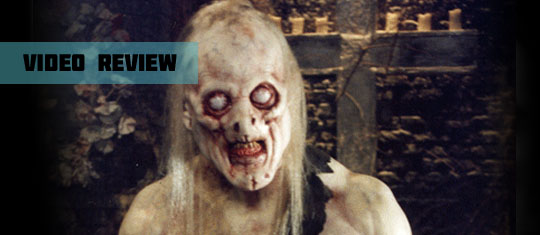
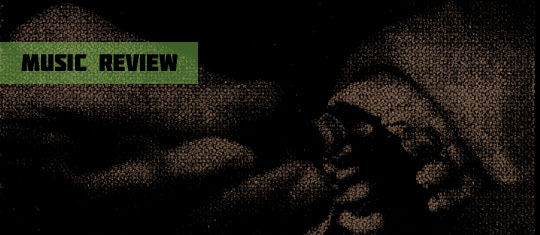
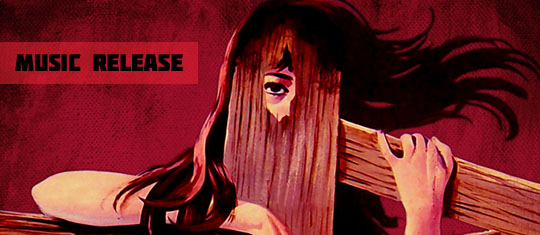
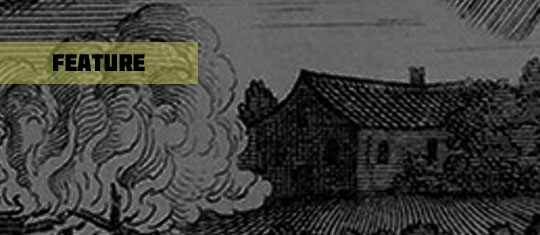
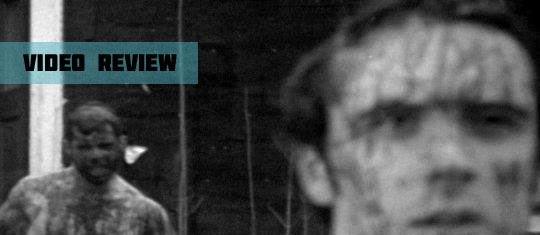
 Follow
Follow